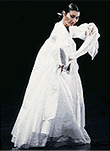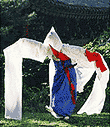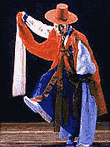|
|
|
 |
Best
of Korea |
Korean culture has blossomed during her
long history. Although influenced by other Asian cultures, there is still
a strong semblance of the creative Korean. Other countries, especially
Japan, have even adopted Korean ideas and customs. Korea has spawned some
great inventors. Its first printing systems predated Gutenberg's. The
famous 'Turtle Ship' was the first ironclad battleship and the Korean
alphabet, Han-gul, which was devised by a group of scholars in the 15th
Century, was so effective that it remains largely unchanged. The reasons
behind Korea's rapid economic development can be found in the Korean people's
innate creativity.
Religion
& Philosophy
Above all things, Buddhism stresses on
human virtue, thus aiming to gain spiritual enlightenment in Korea. Buddhism
has also played a powerful role in Korean art. A large number of excellent
examples of Korean artwork and architecture can be found in Buddhist temples
and paintings. On the other hand, Confucianism requires one's life to
be regulated by natural laws. It was the major thought and basic system
in the Choson Dynasty. Confucianism became the leading inspiration for
many past artisans. Both Buddhism and Confucianism have played major roles
in developing Korean culture.
Salp'uri
 Salp'uri
is derived from shamanic ceremonies, which is aimed at spiritual cleansing.
The word salp'uri means "eliding a murderous evil spirit" and the dance
was actually intended to appease evil. Today, however, salp'uri is almost
always performed for artistic purposes and is considered one of Korea's
most creative traditional dance forms. With a long white scarf, a white
hanbok (traditional Korean dress) and a graceful turn of her white-clad
ankle, the dancer bobs and turns, thus creating a thousand fluid lines.
This dance expresses the beauty and sadness of human emotions in both
relationships and separations. Numerous instruments including a kayagum,
a long twelve-stringed zither, a bamboo oboe, a long bowed zither, and
an hourglass drum act as accompaniments. The music starts off slow and
plaintive. The pace gradually quickens, thus building emotions, only to
come to a quiet and thoughtful end. Salp'uri
is derived from shamanic ceremonies, which is aimed at spiritual cleansing.
The word salp'uri means "eliding a murderous evil spirit" and the dance
was actually intended to appease evil. Today, however, salp'uri is almost
always performed for artistic purposes and is considered one of Korea's
most creative traditional dance forms. With a long white scarf, a white
hanbok (traditional Korean dress) and a graceful turn of her white-clad
ankle, the dancer bobs and turns, thus creating a thousand fluid lines.
This dance expresses the beauty and sadness of human emotions in both
relationships and separations. Numerous instruments including a kayagum,
a long twelve-stringed zither, a bamboo oboe, a long bowed zither, and
an hourglass drum act as accompaniments. The music starts off slow and
plaintive. The pace gradually quickens, thus building emotions, only to
come to a quiet and thoughtful end.
The
Monk's dance
 Although
the monk's dance is not part of any Buddhist ritual, it is a good example
of Buddhism's influence on Korean culture. The dancer is dressed in a
long robe topped with a bright red changsam, a mantle worn by Buddhist
monks in ceremonies. This solo dance combines a number of elements, such
as reverence, longing, and great energy. It is performed to the beat of
a single drum that begins slowly. The tension then builds up as the dancer
portrays the path to enlightenment in seven scenes. Although
the monk's dance is not part of any Buddhist ritual, it is a good example
of Buddhism's influence on Korean culture. The dancer is dressed in a
long robe topped with a bright red changsam, a mantle worn by Buddhist
monks in ceremonies. This solo dance combines a number of elements, such
as reverence, longing, and great energy. It is performed to the beat of
a single drum that begins slowly. The tension then builds up as the dancer
portrays the path to enlightenment in seven scenes.
Shamanic
Dance
 Shamanism
came about because of an ancient reverence for nature. It has influenced
art, literature, music, and dance throughout Korean history. Shamanic
rites are a fascinating conglomerate of all these cultural elements. The
dance itself is extremely artistic because it is derived from the desire
to express human emotion. However, they are also practical and public
oriented, serving the needs of the community. Dances in shamanic rites
are generally performed when the shaman greets spirits. Good spirits are
welcomed and escorted to the "other world", whereas bad spirits are greeted
with combative gestures and driven away. Jumping and turning are characteristic
movements. Shamanism
came about because of an ancient reverence for nature. It has influenced
art, literature, music, and dance throughout Korean history. Shamanic
rites are a fascinating conglomerate of all these cultural elements. The
dance itself is extremely artistic because it is derived from the desire
to express human emotion. However, they are also practical and public
oriented, serving the needs of the community. Dances in shamanic rites
are generally performed when the shaman greets spirits. Good spirits are
welcomed and escorted to the "other world", whereas bad spirits are greeted
with combative gestures and driven away. Jumping and turning are characteristic
movements.
Top of Page
|
